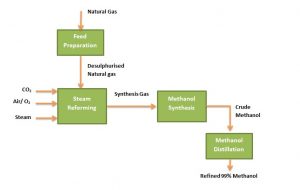Trinidad’s Methanol Industry
Trinidad’s methanol industry dates back to 1984, when the government-owned Trinidad and Tobago Methanol Company (TTMC) started up its first plant at Point Lisas. From that time, the industry has expanded to include six larger plants with an annual production capability over 6 million metric tonnes (MT) of methanol.
Methanol Holdings (Trinidad) Limited (MHTL) is one of the largest methanol producers in the world with a total capacity of over 4 million MT annually from its five (5) methanol plants located at the Point Lisas Industrial Estate. The company is the largest supplier of methanol to North America and is also a significant supplier to the European Market. The five plants use the ICI Low Pressure Process:
- TTMC Plant I (TTMC I) – [M1]
- Caribbean Methanol Company Plant (CMC) – [M2]
- TTMC Plant II (TTMC II) – [M3]
- Methanol IV Plant – [M4]
- M5000 Plant – [M5]
Methanex is also one of the largest methanol producers in the world with a total capacity of over 2.5 million MT annually from its two (2) methanol plants located at the Point Lisas Industrial Estate. The company supplies North America, Europe and the Caribbean. These two plants use the Lurgi Mega Methanol Technology:
- Titan Plant
- Atlas Plant
The Table below shows the data on the above mentioned methanol plants:
| Plant | Owner | Startup Year | Technology | Annual Capacity (MT/yr) |
| TTMC I (M1) | MHTL | 1984 | ICI Low Pressure Process | 480,000 |
| CMC (M2) | MHTL | 1993 | ICI Low Pressure Process | 550,000 |
| TTMC II (M3) | MHTL | 1996 | ICI Low Pressure Process | 570,000 |
| Methanol IV (M4) | MHTL | 1998 | ICI Low Pressure Process | 580,000 |
| Titan | Methanex | 1999 | Lurgi Mega Methanol | 850,000 |
| Atlas | Methanex | 2004 | Lurgi Mega Methanol | 1,825,000 |
| M5000 (M5) | MHTL | 2005 | ICI Low Pressure Process | 1,890,000 |
| Methanol Plant | CGCL | 2020 | Mitsubishi Methanol Process | 1,000,000 |
Methanol, also known as methyl alcohol, is a colorless, neutral, volatile and flammable liquid with the chemical formula CH3OH. It is the simplest alcohol, a polar liquid and miscible with water, esters and most other organic solvents. It is only slightly soluble in fats and oils. Commercial grade methanol has a purity of 99%. Methanol is usually produced via a catalytic process which uses natural gas and steam as feedstock.
Di-Methyl Ether (DME) is a synthetic product that is produced through the dehydration of methanol. It has physical properties similar to Liquefied Petroleum Gas (LPG) and can be easily compressed to a liquid. DME can be derived from many sources including renewable feedstocks such as biomass and waste as well as from fossil fuels like natural gas and coal. DME is used in the personal care industry, household use fuel, transportation fuels, power generation fuels, as a refrigerant and as chemical feedstocks. DME can be blended with LPG for use in domestic cooking.
| Plant | Owner | Startup Year | Technology | Annual Capacity (MT/yr) |
| DME Plant | CGCL | 2020 | Mitsubishi Gas Company Process | 20,000 |
Methanol Production-Process Overview
Methanol is produced via four stages:
- Feed Preparation
- Steam Reforming
- Methanol Synthesis
- Methanol Distillation
The methanol production process is briefly outlined in the flow chart below:
At the start of the production process, the natural gas feedstock is desulphurised in order to reduce sulphur content. The natural gas is then compressed and routed to the steam reformers to create synthesis gas (syngas) which is a mixture of hydrogen (H2) and carbon monoxide (CO) in different ratios. The steam reforming process transforms methane (CH4) – which is the main constituent of natural gas- and steam into hydrogen, carbon monoxide and carbon dioxide (CO2) via the following reactions:
Another natural gas reforming process includes partial oxidation in which natural gas reacts with a limited amount of oxygen (typically from air) that is not enough to completely oxidize the methane to carbon dioxide and water. The process is typically much faster than steam reforming and requires a smaller reactor vessel, however less hydrogen is produced. The partial oxidation of methane reaction is as follows:
Carbon dioxide is also added to the feed gas stream at this stage to produce a mixture of components in the ideal ratio (Le Chatelier’s Principle) to efficiently produce methanol.
The synthesis gases are then sent to the methanol synthesis reactor to produce methanol via the following chemical reactions:
CO + 2H2 → CH3OH
CO + H2O → CO2 + H2
CO2 + 3H2 → CH3OH + H2O
Crude methanol which has a purity of 68% is produced, condensed and then sent to a distillation column to be refined. The refined methanol out of the distillation column has a purity of about 99% and is classified as Grade AA refined methanol.
Uses of Methanol
Methanol is mostly used as a feedstock in the manufacture of chemical products. Some of its major uses include:
- In the automobile industry in blended fuels
- In the production of methyl tertiary-butyl ether (MTBE) which is used to reduce the gaseous emissions of aromatic compounds.
- To produce acetic acid which is used in the production of photographic film, rayon and other organic solvents
- To produce formaldehyde which is extensively used in the manufacture of adhesive, coatings, resin plastic, explosive, dyestuff, pharmaceuticals and pesticides.
